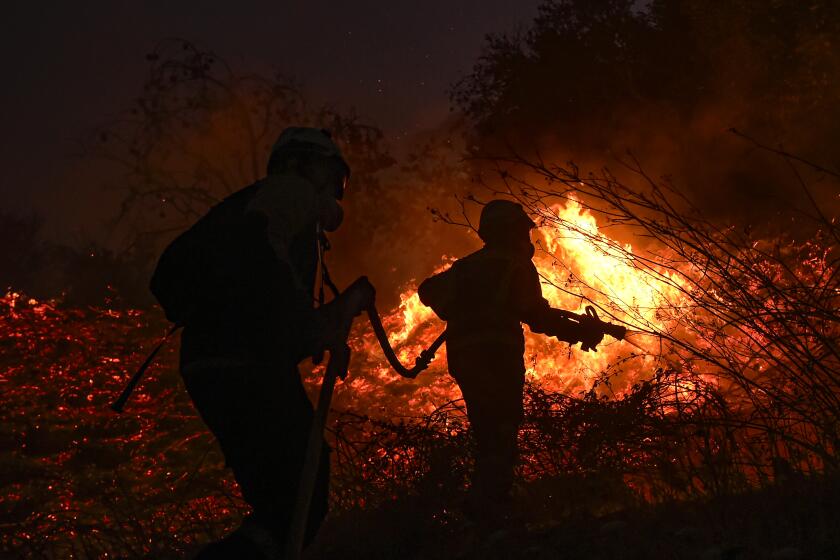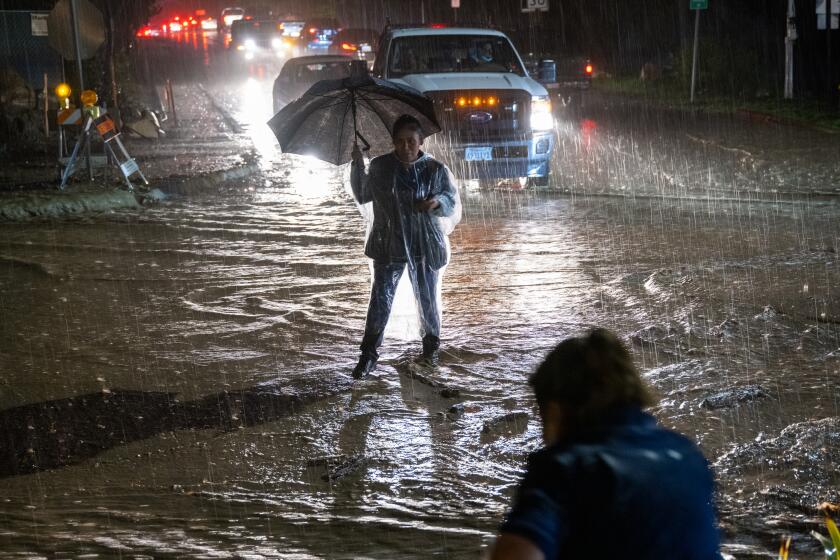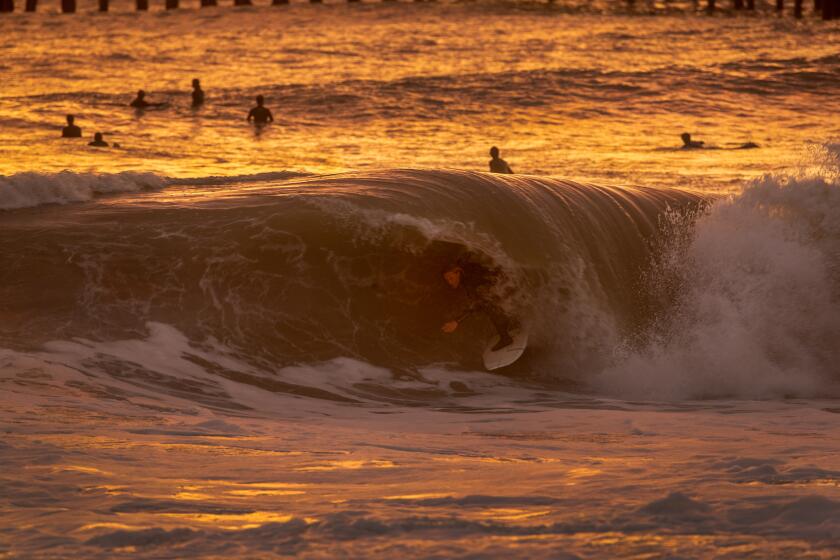
- Share via
After a blistering summer of record heat, raging wildfires and unpredictable storms, federal scientists on Thursday said a warm, wet winter driven by El Niño is in store for California and much of the rest of the country.
The first winter outlook from the National Oceanic and Atmospheric Administration predicts that a strong El Niño will remain in place through at least the spring, with further strengthening possible over the next couple of months.
El Niño is the warm phase of the El Niño-La Niña Southern Oscillation pattern — sometimes referred to as ENSO — and is a major driver of temperature and precipitation patterns across the globe.
“The anticipated strong El Niño is the predominant climate factor driving the U.S. winter outlook this year,” said Jon Gottschalck, chief of the operational prediction branch at NOAA’s Climate Prediction Center.
Aggressive and impactful reporting on climate change, the environment, health and science.
Temperature forecasts for December, January and February favor warmer-than-average conditions across the northern tier of the U.S. and much of the West, with the highest chance of above-normal temperatures expected in Northern California, the Pacific Northwest and northern New England. Odds are tilted toward warmth in Central and Southern California as well.
Much of the Bay Area and inland Southern California are under heat advisories through Thursday, with high temperatures expected.
The forecast also favors wetter-than-average conditions in many regions of the country, including nearly all of California, the southern Plains, Texas and the Southeast. Widespread drought will persist across much of the central and southern U.S., but not in California, where the Central Valley and San Francisco Bay area have the highest odds in the state of above-normal rainfall.

The outlook conjures the specter of another soggy season for the Golden State, which was pummeled by 31 atmospheric river storms, deadly floods and record-setting snow last winter.
Gottschalck said the combination of wetness and warmth means more precipitation is likely to fall as rain instead of snow. But he and other experts also said it’s too soon to say whether California will see a repeat of the atmospheric rivers it experienced at the start of this year.
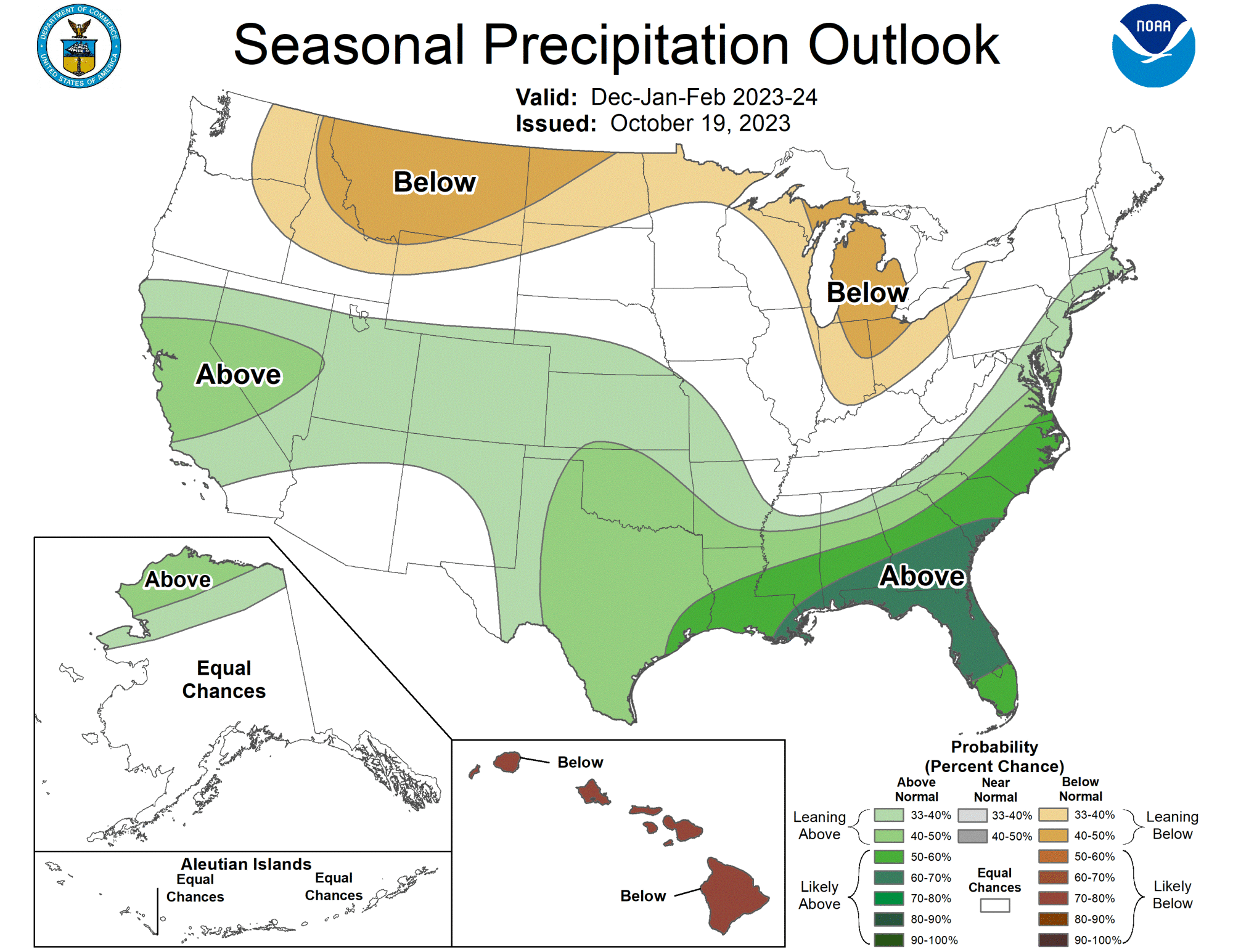
“It’s important to stress that even though we see these general patterns during El Niño and La Niña years, there is still a lot of variability and not every event is going to follow the general pattern,” Julie Kalansky, a climate scientist at the Center for Western Weather and Water Extremes at the Scripps Institution of Oceanography, said in a recent El Niño update.
Kalansky noted that last year’s La Niña was a perfect example, as the state received a deluge of moisture despite the pattern’s association with drier conditions in Southern California.
“So, the declaration of an El Niño doesn’t guarantee that Southern California is going to have a wet, stormy winter, but it does stack the deck in that direction,” she said.
Global surface temperatures last month were 2.25 degrees above the 20th century average of 60.1 degrees, surpassing the record set in August 2016.
The wet outlook follows the planet’s hottest summer ever recorded.
Global average surface temperatures in June, July, August and September were the highest they’ve ever been, marked by sizzling heat waves in Europe, China and the southwestern U.S. — including a record 31 consecutive days of high temperatures at or above 110 degrees in Phoenix.
September was so hot — 2.59 degrees above the 20th century average of 59 degrees — that it also broke the record for the highest monthly global temperature anomaly, or the largest difference from the long-term average, NOAA officials said.
Zeke Hausfather, a climate scientist at the nonprofit Berkeley Earth, called the month’s temperature data “absolutely gobsmackingly bananas.”

The September data and winter forecast make it 99% certain that 2023 will end up as the planet’s hottest year on record, according to Gavin Schmidt, director of the NASA Goddard Institute for Space Studies. Currently, 2016 and 2020 are tied for that record.
Schmidt said this year’s monthly heat records are particularly remarkable because they are occurring before the peak of the current El Niño event. Other hot periods, including in 2016 and 2020, happened after the peak of El Niño.
That doesn’t bode well for what might be in store next spring, he said.
“I would anticipate that 2024 is still going to be warmer than 2023, even given the ‘gobsmackingly bananas’ anomalies that we’ve had this summer,” Schmidt said. “What we would predict for next year, based just effectively on the long-term trend and the predicted level of ENSO going into next year, is that it will be warmer again — and by quite a lot.”
There is an 84% chance the system will be of moderate strength, and a 56% chance it will become a strong event at its peak, forecasters said.
Schmidt said he was surprised by the unusually high temperatures this summer. Persistent climate warming driven by the burning of fossil fuels is to be expected, as are warmer global temperatures linked to El Niño, but scientists are still seeking answers about why 2023 has been so off-the-charts.
Some theories include a recent change to shipping regulations concerning aerosols, which reduced the upper limit of sulfur in fuels. The change was geared toward cleaner air in ports and coastal areas but may have had an unintended planetary warming effect because the aerosols were reflecting sunlight away from Earth.
A dearth of Saharan dust, possibly linked to weakened trade winds from El Niño, could also be a warming factor since the dust normally has a cooling effect on the North Atlantic, Schdmit and other researchers said.
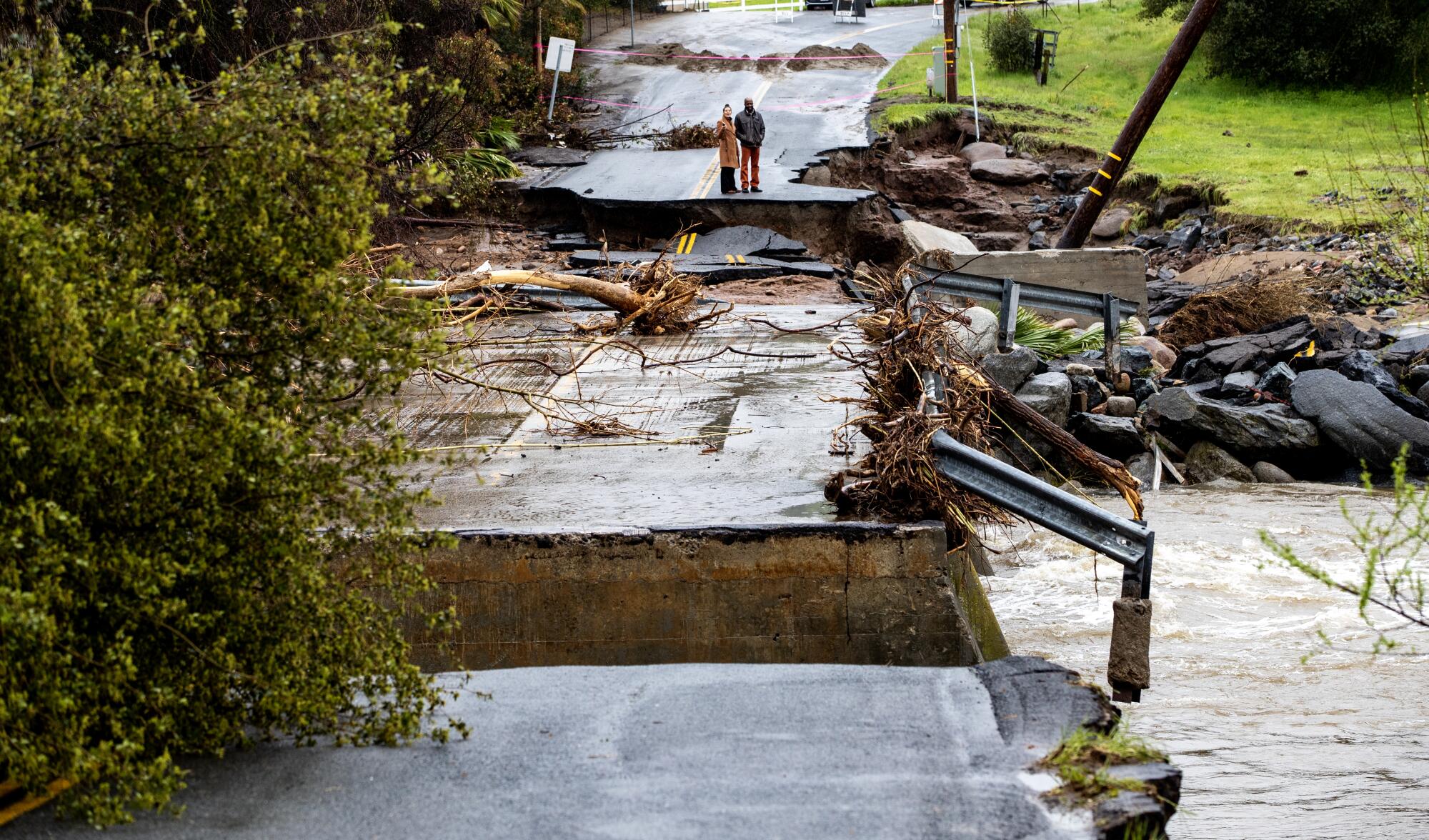
Additionally, the eruption of the Hunga Tonga-Hunga Ha’apai volcano in 2022 shot record-breaking amounts of water vapor into the stratosphere, which can act as a heat-trapping greenhouse gas.
“But all of the quantitative estimates of how big those effects are are way too small to explain what’s going on,” Schmidt said. “This is not a neat story. It could be the long-term trends, plus ENSO, plus a little bit from the volcano, plus a little bit from the marine shipping emission changes, plus quite a large chunk of internal variability.”
Unprecedented warming in the North Atlantic has startled some researchers. While global warming is the underlying cause, a variety of other factors are at play.
Indeed, he said that while the long-term trends point to continued warming, there are likely to be years in the future that are cooler than 2023.
What is indisputable, though, is that people are already experiencing the effects of warmer temperatures — including extreme rainfall, extended droughts, heat waves and sea level rise — through their impacts on infrastructure, coral reefs, fishing, crop yields and other sectors, Schmidt said.
NOAA experts said this year’s El Niño probably won’t be as severe as the one in 2015-16, which ranked as a “very strong El Niño,” but that it would still be wise for the West Coast to ready itself for more El Niño-fueled moisture. This month, state officials said they are taking steps to prepare for such a possibility, including assembling flood control material and sandbags, and providing funds for critical levee repairs.
With great abundance comes risk. Forecasters are warning of another potentially wet winter fueled by El Niño, which could bring levee breaches and flooding.
Though the winter storms significantly eased drought conditions in California, the soggy winter was among dozens of billion-dollar climate disasters in the U.S. this year, with flooding in the state between January and March causing about $4.2 billion in damage, according to NOAA. In August, Tropical Storm Hilary dropped more than a year’s worth of rain in a single day in several regions of the state.
Other billion-dollar disasters in the U.S. include major flooding in New York, Hurricane Idalia in Florida and a devastating firestorm in Hawaii.
“So far this year we’ve had 24 confirmed billion-dollar disasters, which is already a record-breaking amount,” said Tom Di Liberto, a climate scientist with NOAA. “And we still have October, November and December to go.”



